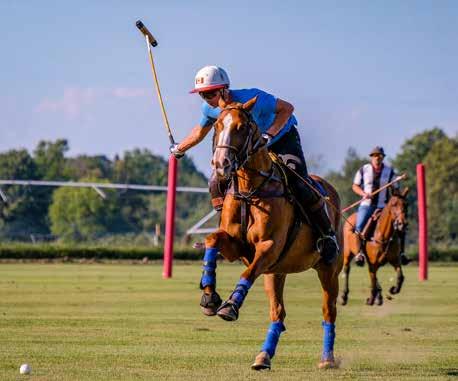
6 minute read
A Celebration of Polo Ponies in Canada
from History of Polo
by MediaEdge
“Chapa Sonambulo” owned by Craig Nelson. Painting by Melinda Brewer
The term “polo pony” dates back to the late 1800s when polo ponies were actually subject to height restrictions. Specifically, polo ponies were not to exceed 14 hands 2 inches—the definition of a pony, with each hand representing four inches.
When the United States Polo Association was founded in 1890, the set of standard rules established in Great Britain were adopted, among them the height restriction for a player’s mount. In 1915, the size limit was increased to 15 hands 1 inch, and by 1920 the ruling on height was dropped completely.
Today, the term “polo pony” simply describes a horse that plays polo, and although many are still small in stature, it is recognized more as a “type” than a specific height or breed. A polo pony can come in various sizes and shapes, from 15 hands (or
The members of The Canadian Polo Association were invited to submit photographs of their own equine superstars to be featured in this book. In this celebration of the polo pony, we pay tribute to these great horses.

2


3


1
smaller) to 16 hands (and appear much larger!). Certainly, the modern-day polo pony is unique in the equine world as it must be quick and agile, sensitive, and brave, athletic with stamina, and have a willing and generous temperament to withstand the demands of competition on the field. Additionally, a polo pony must be able to focus and be attentive to the rider. It is said that some of the greatest ponies seem to understand the game and the role they play in getting the player to the ball at the right time.
HORSE BREEDING
Most polo ponies are thoroughbred or a thoroughbred-type, as many of the exceptional characteristics of the racehorse—like speed and stamina—are also good qualities for polo. However, many polo ponies can be crossed with quarter horses, or even ranch horses, which can lend the sturdiness, reliability, and steadfast temperament. Today there are many breeding technologies and organizations that have encouraged the development of the “polo pony type”. Some polo ponies have pedigrees that can be traced back generations through the various breed registries, such as the Thoroughbred Registry and the Argentine Association of Polo Pony
4
5


6 7

1 “Val” and “Loki” owned by Chris Wright. Painting by Melinda Brewer 2 Heidi Clark on her favourite pony “Nina” 3 Garrett Smith on “Ally” 4 ‘Best Playing Pony’ award presented to Chris Wright’s horse “Loki” at Greater Niagara Polo Club 5 John Benitz on “King” 6 Gerald Levin on “Tiger” 7 Retired polo ponies “Sienna” and “Paloma” babysitting the next generation


1
Breeders (AACCP). In the United States, the American Polo Horse Association is documenting the pedigrees of the polo pony. There are also some renowned polo ponies playing at all levels with unknown breeding or pedigree, perhaps discovered in a field or a backyard. This is what makes this sport so unique and the horses so special.
EQUINE SUPERSTARS
The members of The Canadian Polo Association were invited to submit photographs of their own equine superstars to be featured in this book. The response was overwhelming. All the horses have wonderful stories. Some were exceptionally talented on the playing field, putting their hearts into every game they played. Others reached superstar status simply because of their outstanding temperaments. Many of the ponies lived well into their twenties and early thirties, carrying generations of players on their backs. All of them are special in their own way and are well-deserving of the love and respect of their owners or players. In this celebration of the polo pony, we pay tribute to these great horses.

1
2
3
4



5 6 7

1 String of greys, owned by Craig Nelson. Painting by Melinda Brewer 2 Versatile, multi-purpose horses are common in the West 3 Steve Flowers on “Dakota” 4 “Snake” owned by Cliff Sifton. Photo courtesy of Marianne McBean 5 Penny Davey with “Acorn” 6 Bill Gerrie on “Dexter” 7 Ottawa Polo Club member Linda Porebski and “Dot”, owned by Barry Cloete

1



3 2
4

5


6 7 8

1 Hailey Van der Burgt on “Chianti” 2 “Saffira” and “Matita”, owned by the Van der Burgt family. Painting by Melinda Brewer 3 CJ Sifton on “Taba” 4 “Bonita”, owned by Don Pennycook, receives 2015 Best Playing Pony Award at Club Nacional 5 “Juicy Fruit” owned by the Houlton’s. Painting by Melinda Brewer 6 “Jax”, owned by Robert Campbell and pictured with Ottawa Polo Club player Carol MacLeod, has helped many people in the National Capital learn to play polo 7 “Pantera” owned by the Smith family 8 Molly Houlton on “Pompita”

1


2 3

5

4 6

1 Garrett Smith on “Little White”. The sturdy little welsh pony taught the Smith kids how to ride and play 2 Dianne Chailler on “Angel” 3 Dave Offen on “Whisper” in the 1995 U.S. Open 4 Brad Buie on “Romeo” 5 Hannah Tuplin with her horse “Muneco,” another former high goal pony who taught her how to play 6 “Travis”, owned by Ottawa Polo Club member Melissa Gagnon and pictured with Sean Taylor. Photo courtesy of Stephen J. Thorne












